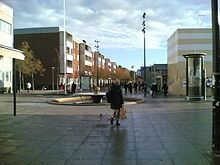Area 234 ha | Province Stockholm Time zone CET (UTC+1) Population 17,083 (31 Dec 2007) | |
 | ||
Tensta is a district in Spånga-Tensta borough, Stockholm, Sweden. There are about 6,000 apartments in Tensta and a population of 17,083 as of December 31, 2007.
Contents
Map of Tensta, Stockholm, Sweden
Modern Tensta, with its Plattenbau-style concrete apartment buildings, was constructed in the 1960s. Like nearby Rinkeby and Hjulsta, it was part of the Million Programme, and became known nationwide in the late 1960s. This was partially because lots of people moved in when the area was still a construction site, and it took years before the metro station opened (in 1975).
In the center of Tensta there is a small fruit market. The art gallery Tensta Konsthall is also situated close to the centre and has gained a name in Sweden and abroad.
The government has decided to award to 200 million kronor ($30 million) in performance based subsidies to boost fifteen of Sweden’s suburbs grappling with social exclusion. Tensta is one of the suburbs that have chosen to receive this cash injection. The districts will receive the cash injection at the end of 2013 at the earliest, after the results from the past year have been evaluated. The subsidy - which is performance based - will be awarded for three criteria: how the areas deal with education, employment, and social benefits.
History
When the farm of Stora Tensta was demolished in the 1960s, it had probably stood on the same site for more than a thousand years.
Tensta is situated on the Järva field, which was used as a military training ground from 1907. The area was closed to the public. Several farms continued growing crops and raising livestock throughout the time the army exercised here, but the farmers were not allowed to cultivate virgin soil or erect new building.
In 1962 the government decided that almost the whole training ground should be made available for civil buildings. The aim was to build enough homes to eliminate the housing shortage. People living in cramped city flats without modern conveniences, and all the people moving to Stockholm, would acquire spacious and comfortable homes. The construction of Tensta went very fast. The general plan was approved in 1965. People began to move in two years later, and Tensta Centre was opened in 1970. The first inhabitants, mostly families with young children, lived for many years as pioneers on a building site with provisional bus lines, temporary food stores in huts, unfinished paths, and inadequate social service. The Metro (also known as Tunnelbana) came to Tensta in 1975. The lime-lined avenue of Tenstagången leads straight through the district.
